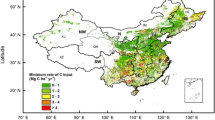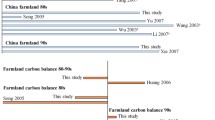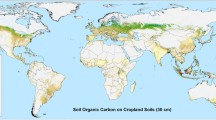Abstract
It is generally accepted that cropland soils could be managed to store significant carbon (C), however little information is available regarding the cropland soil C sequestration potential of the Loess Plateau in northern China. This study aimed to estimate the cropland soil C sequestration potential in this area using the United Nations Intergovernmental Panel on Climate Change (IPCC) method with region-specific C stock change factors. The results show that the C sequestration potential can reach 6.054 Tg C yr−1 (1Tg = 1012 g) in cropland soils of the Loess Plateau using techniques that are currently available (no-tillage and high residue incorporation). Although the results show a high degree of uncertainty in this estimate with 95 % confidence interval ranges from 2.623 to 11.94 Tg C yr−1, our study suggests that cropland soil C sequestration could play a meaningful role in helping to mitigate greenhouse gas increases in the Chinese Loess Plateau.


Similar content being viewed by others
Notes
In this study, the base factors (BF) are equal in all scenarios as they are all cultivated soil.
References
Álvaro-Fuentes J, López MV, Arrúe JL et al (2009) Tillage and cropping effects on soil organic carbon in Mediterranean semiarid agroecosystems: testing the Century model. Agr Ecosyst Environ 134:211–217
Antle JM, Valdivia R (2006) Modeling the supply of ecosystem services agriculture: a minimum-data approach. Aust J Agr Resour Econ 50:1–15
Batjes NH, Sombroek WG (1997) Possibilities for carbon sequestration in tropical and subtropical soils. Global Change Biol 3:161–173
Baument KA, Herzog T, Pershing J (2005) Navigating the numbers: Greenhouse gas data and international climate policy. World Resources Institute, Washington DC
Bernoux M, Carvalho MCS, Volkoff B, Cerri CC (2001) CO2 emission from mineral soils following land-cover change in Brazil. Global Change Biol 7:779–787
Biradar CM, Thenkabali PS, Noojipady P et al (2009) A global map of rainfed cropland areas (GMRCA) at the end of last millennium using remote sensing. Int J Appl Earth Observation Geoinformation 11:114–129
Cai LQ, Qi P, Zhang RZ (2008) Effects of conservation till age measures on soil aggregates stability and soil organic carbon in two sequence rotation system with spring wheat and field pea. J Soil Water Conserv 22(4):141–145
Cai LQ, Qi P, Zhang RZ (2009) Effects of different conservation tillage measures on soil organic carbon pool in two sequence rotation systems of spring wheat and pease. Chin J Eco-Agr 17(1):1–6
Cao JJ (2009) Extension of eonservation tillage and project management. http://www.amic.agri.gov.cn/DesktopModules/Infos11/Infos/ThisInfo.aspx?ItemID=70650. Cited 22 April 2011
IPCC (Intergovernmental Panel on Climate Change) (2006) 2006 IPCC Guidelines for National Greenhouse Gas Inventories, Prepared by the National Greenhouse Gas Inventories Programme. Japan
Cole CV, Flach K, Lee J, Sauerbeck D, Stewart B (1993) Agricultural sources and sinks of carbon. Water Air Pollut 70:111–122
Coleman K, Jenkinson DS (1996) RothC-26.2-Amodel for the turnover of carbon in soil. In: Powlson DS, Smith JU (eds) Evaluation of soil organic matter models using existing, long-term datasets. NATO ASI Series I, Vol 38. Springer, Berlin
Davidson EA, Janssens IA (2006) Temperature sensitivity of soil carbon decomposition and feedbacks to climate change. Nature 440:165–173
Eve MD, Sperow M, Paustian K et al (2002) National-scale estimation of changes in soil carbon stocks on agricultural lands. Environ Pollut 116:431–438
Fan LQ, Nan ZB, Shen YY et al (2005) Effects of conservation tillage practices on soil microbial biomass carbon in wheat field in the Loess Plateau. Grassland and Turf 4:51–56
Fang J, Liu GH, Xu SL (1996) Carton reservoir of terrestrial ecosystem in china, in monitoring and relevant process of greenhouse gas concentration and emission. China Environmental Science Publishing House, Beijing
Feng Z, Li X (2000) The strategies of cultivated land and food supplies security: storing food in land-raising the comprehensive productivity of land resource of China. Geogr Terr Res 16(3):1–5
Flach KW, Barnwell TO, Crosson P (1997) Impacts of agriculture on atmospheric carbon dioxide. In: Paul EA, Paustian K, Elliot ET, Cole CV (eds) Soil organic matter in temperate agroecosystems. CRC Press, Boca Raton
Fu Z, Cai Y, Yang Y et al (2001) Research on the relationship of cultivated land change and food security in China. J Nat Resour 16(4):313–319
Government of the People’s Republic of China (2004) The People’s Republic of China Initial National Communication on Climate Change. Beijing
Houghton RA, Hackler JL (2000) Changes in terrestrial carbon storage in the United States I: the role of agriculture and forestry. Global Ecol Biogeogr 9:125–144
Houghton RA, Hackler JL, Lawrence KT (1999) The U.S. carbon budget: contributions from land-use change. Science 285:574–578
Hu N, Lou YL, Liang L (2009) Soil organic C and N stocks as affected by the conservation tillage. Ecol Environ Sci 18(6):223–226
Jin L, Li YE, Gao QZ et al (2008) Estimate of carbon sequestration under cropland management in China. Scientia Agricultura Sinica 41(3):734–743
Kang X, Huang J, Lu JZ et al (2009) Effects of conservation tillage on soil nutrient and organic carbon pool ecology and environmental sciences 18(6):2339–2343
Lackner KS (2003) A guide to CO2 sequestration. Science 300:1677–1678
Lal R (2004) Soil carbon sequestration impacts on global climate change and food security. Science 304:1623–1627
Lal R, Kimble JM, Follett RF et al (1998) The potential of U.S. cropland to sequester carbon and mitigate the greenhouse effect. Ann Arbor Press, Chelsea
Lewandrowski J, Peters M, Jones C et al (2004) Economics of sequestering carbon in the U.S. agricultural sector. USDA-ERS Technical Bulletin Number 1909, Washington, DC
Li C, Frolking S, Harriss RC (1994) Modeling carbon biogeochemistry in agricultural soils. Global Biogeochem Cy 8:237–54
Li L, Li SJ, Zhang HL et al (2006) Study on soil C pool management index of conservation tillage. J Soil Water Conserv 20(3):106–109
Liu XH (2008) Present situation and prospect of conservation tillage in China. Res Agr Mod 29(2):208–212
Lu F, Wang X, Han B et al (2009) Soil carbon sequestrations by nitrogen fertilizer application, straw return and no–tillage in China’s cropland. Global Change Biol 15:281–305
Luo ZZ (2005) The effect of conservation tillage on topsoil infiltration in Loess Plateau. Master’s thesis, Gansu agricultural University, Lanzhou
Melillo JM, Borchers J, Chaney J et al (1995) Vegetation/ecosystem modeling and analysis project comparing biogeography and biogeochemistry models in a continental-scale study of Climatic Change terrestrial ecosystem response to climate change and CO2 doubling. Global Biogeochem Cy 9:407–437
Ogle SM, Breidt FJ, Eve MD et al (2003) Uncertainty in estimating land use and management impacts on soil organic carbon storage for US agricultural lands between 1982 and 1997. Global Change Biol 9:1521–1542
Pan G, Li L, Wang X (2005) Organic carbon stock in top soil of Jiangsu Province, China, and the recent trend of carbon sequestration. J Environ Sci 2:1–7
Pang L, Huang GB (2006) Impact of different tillage method on changing of soil organic carbon in semi-arid area. J Soil Water Conserv 20(3):110–113
Paustian K, Antle JM, Sheehan J et al (2006) Agriculture’s role in greenhouse gas mitigation. Pew Center on Global Climate Change, Arlington, VA
Post WM, Kwon KC (2000) Soil carbon sequestration and land-use change: processes and potential. Glob Change Biol 6:317–327
Schlesinger WH (1977) Carbon balance in terrestrial detritus. Annu Eev Ecol Syst 8:51–81
Shan L (1994) Water use efficiency of plant and water utilization of agriculture in semi-arid areas. Plant Physiol Commun 30:61–66
Shi H, Shao MA (2000) Soil and water loss from the Loess Plateau in China. J Arid Environ 45:9–20
Smith P (2004) How long before a change in soil organic carbon be detected? Glob Change Biol 10:1878–1883
Smith JE, Heath LS (2001) Identifying influences on model uncertainty: an application using a forest carbon budget model. Environ Manage 27:253–267
Sperow M, Eve M, Paustian K (2003) Potential soil C sequestration on U.S. agricultural soils. Climatic Change 57:319–339
US EPA (United States Environmental Protection Agency) (1997) Guiding principles for Monte Carlo analysis. US EPA, Risk Assessment Forum, Washington, DC 01 March 1997
VandenBygaart AJ, Gregorich EG, Angers DA et al (2004) Uncertainty analysis of soil organic carbon stock change in Canadian cropland from 1991 to 2001. Global Change Biol 10:983–994
Wang XJ (2009) Effects of conservation tillage on soil organic carbon and other characteristics. Master’s thesis, Gansu agricultural University, Lanzhou
Wang FT, Liu WQ (2003) Preliminary study of climate vulnerability of agro-production in the Loess Plateau. Climatic Environ Res 8(1):91–100
Wang J, Cai LQ, Bi DM et al (2009a) Effects of conservation tillage on the SOC, TN, SMBC and SMBN in two seguence rotation systems with spring wheat and pea. J Agro-Environ Sci 29(7):1516–1521
Wang XJ, Zhang RZ, Bi DM et al (2009b) Effects of conservation tillage on soil organic carbon fractions. J Soil Water Conser 23(2):115–121
Wang CX, Yue XJ, Ge XZ et al (2010a) Effect of different cultivation measures on activitv and bound foms of orgaIlic carbon in Lou Soil. Agricultural Research in the Arid Areas 28(6):58–53
Wang CX, Wang XD, Zhu RX (2010b) Effect of conservational tillage measures on distributions of organic carbon and nitrogen in soil aggregates. J Natural Resour 25(3):386–395
Wang CX, Wang XD, Zhu RX (2010c) Effect of conservational tillage measures on the oxidation stability of soil organic carbon in soil aggregates. Chinese Agric Sci Bull 26(5):121–126
Wang YQ, Shao MA, Liu ZP (2010d) Large-scale spatial variability of dried soil layers and related factors across the entire Loess Plateau of China. Geoderma 159:99–108
Xu F (2002) China’s Agriculture and Sustainable Development, in China’s Population Resources Environment and Sustainable Development, Beijing
Yan H, Wang SQ, Wang CY et al (2005) Losses of soil organic carbon under wind erosion in China. Global Change Biol 11:828–840
Yan H, Cao M, Liu J, Tao B (2007) Potential and sustainability for carbon sequestration with improved soil management in agricultural soils of China. Agric Ecosyst Environ 121:325–335
Yang J, Shen YY, Nan ZB et al (2010) Effects of conservatgion tillage on crop yield and carbon pool management index on the top soil within a maize-wheat-soy system in the Loess Plateau. Acta Prataculturae Sinica 19(1):75–82
Zhang XP, Zhang L, Zhao J et al (2008) Responses of streamflow to changes in climate and land use/cover in the Loess Plateau, China. Water Resour Res 44. W00A07, doi:10.1029/2007WR006711
Zhu XM (2006) Rebuild soil reservoir is a rational approach for soil and water conservation on the Loess Plateau. B Chin Acad Sci 21:320–324
Acknowledgements
This research was supported by the National Basic Research Program of China (973) (2007CB 108902). We are very grateful to Mr Joshua Philp (University of Western Sydney, Australia) for his English proofreading assistance.
Author information
Authors and Affiliations
Corresponding author
Rights and permissions
About this article
Cite this article
Tang, Z., Nan, Z. The potential of cropland soil carbon sequestration in the Loess Plateau, China. Mitig Adapt Strateg Glob Change 18, 889–902 (2013). https://doi.org/10.1007/s11027-012-9397-z
Received:
Accepted:
Published:
Issue Date:
DOI: https://doi.org/10.1007/s11027-012-9397-z




